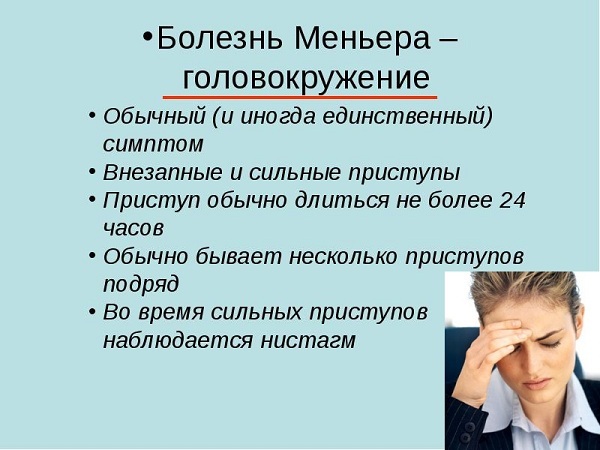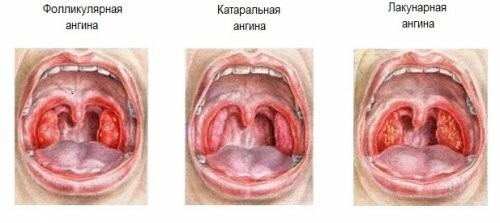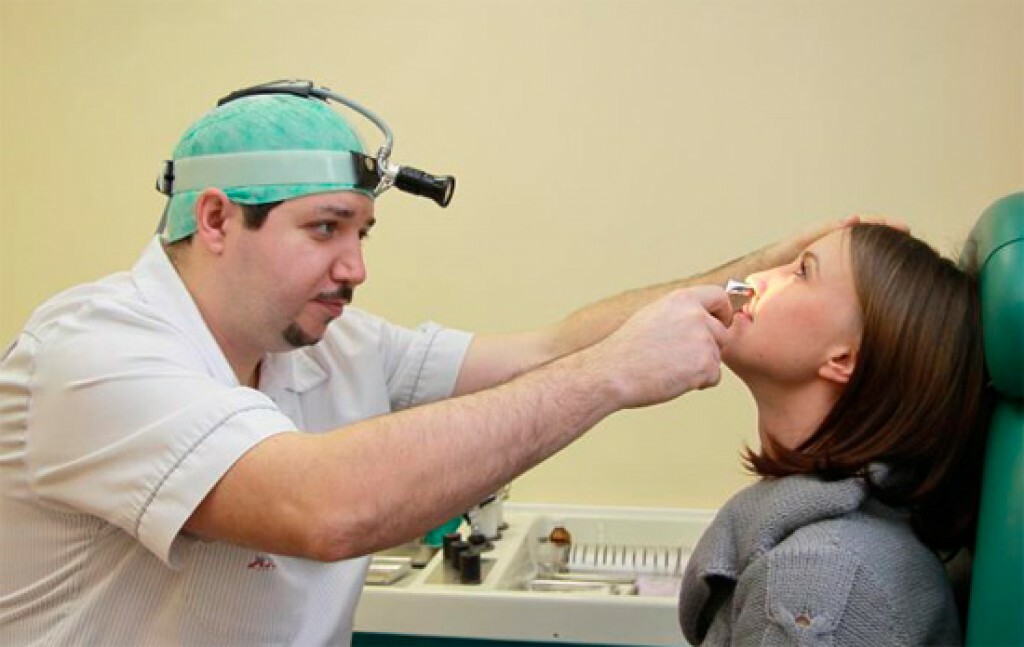Angina Follicular: photos, symptoms, treatment in children and adults
Angina belongs to the group of infectious diseases with local pathological lesions of the lymphatic pharyngeal ring Pirogov, provoked by straphilococci, streptococci, other opportunistic flora of the oral cavity, viruses, fungi.
The provoking factors for the development of follicular sore throat can be:
- chronic foci of infection;
- avitaminosis;
- underdevelopment of lymphatic tissue;
- contact with patients;
- mechanical damage to the mucous membrane of the oropharynx and subsequent bacterial seeding;
- tobacco smoking.
Follicular angina in children is an infectious-bacterial lesion of the reticulo-endothelial system of the oropharynx of streptococcal etiology, in particular follicular apparatus of the tonsils and is characterized by intoxication, pain syndromes and the involvement of regional lymph nodes in the pathological process.
Follicular angina is one of the most common pathologies in childhood and adulthood.
Significant distinctions can be made between sore throat, arising as an independent disease and secondary - a complication of other infectious diseases provoked by streptococcus.
Content
- ICD-10 disease code
- Epidemiology
- Pathogenesis
- Symptoms and clinical manifestations of the disease
- Complications
- Diagnostics
- Differential diagnosis
- Treatment
- Drug treatment
- Prophylaxis
- Related Videos
ICD-10 disease code
In the international classification of diseases of the 10th revision, follicular tonsillitis has a separate code, despite the fact that it is a complication of a respiratory infection or tonsillitis.

Epidemiology

The source of infection is a patient or a carrier of group A beta-hemolytic streptococcus. These can be adults or children who can tolerate:
- tonsillitis;
- sore throat;
- scarlet fever;
- streptoderma and other pathological conditions caused by this pathogen.
Allocate airborne or aerogenic, food and contact-household transmission of infection. Beta-hemolytic streptococcus selectively affects the reticulo-endothelial tissue:
- tonsils;
- The lymph nodes;
- adenoids and so on.
Important! Follicular angina often affects children aged 3 to 7 years, when there is frequent contact with bacteria (it is at this age that the child begins to attend children's groups), adults get sick much less often.
The onset of the disease in children of the first year of life is casuistry due to the action of antimicrobial and antitoxic immunity, received from the mother, as well as due to the anatomical and physiological features of the structure - weak differentiation of the lymphoid ring Pirogov.
Also, elderly people are little susceptible to this disease due to age-related hypoplasia of lymphoid tissue in this population group.
The peak incidence occurs in the autumn-winter time, when the frequency of exacerbation increases chronic tonsillitis and the occurrence of respiratory infections, a decrease in the tension of the protective properties of the immune system.
Pathogenesis
- Group A beta-hemolytic streptococcus affects epithelial cells located on lymphoid tissues.
- Lipoteichoic acid associated with M-protein ensures reliable fixation and penetration of the pathogen into the cell.
- M-protein inhibits the phagocytic ability of macrophages in relation to the pathogen.
- The microorganism causes cell death by its purulent fusion. The process involves not only epithelial cells, but also the parenchyma of the tonsils.
In the natural anatomical structures of the tonsils - follicles, a necrotic mass accumulates, which is visible only macroscopically.
Read also:Symptoms and treatment of chronic tonsillitis in adults at home
Symptoms and clinical manifestations of the disease

Follicular streptococcal angina is preceded by another viral disease. When attaching the bacterial flora in a child already on the first day:
- the body temperature rises sharply to high numbers (39-40 degrees in the axillary fossa);
- chills appear;
- headache;
- weakness or weakness;
- refusal to eat.
One of the main clinical signs is:
- persistent sore throat, and then sore throat, aggravated by swallowing or talking;
- possible irradiation of pain in the neck, temple, ear, shoulder;
- attention is drawn to the pallor of the skin, their dryness, redness of the lips, seizures at the corners of the mouth.
In children of the first months of life or with severe concomitant primorbid background or pathology such as:
- nuclear jaundice;
- perinatal CNS damage;
- defects of the heart and bronchopulmonary system;
- convulsive syndrome may occur;
- psychomotor agitation;
- indomitable vomiting or very frequent regurgitation.
An objective examination of the oral cavity reveals a bright red hyperemia of the mucous membrane of the vestibule, palatine arches, tonsils, uvula, posterior pharyngeal wall.
On the latter one can often see coarse cobblestone grain.
In adolescents, with direct laryngoscopy, you can see limited redness of the tonsils, uvula and posterior pharyngeal wall. During the examination, special attention should be paid to the tonsils (see photo).


They are edematous due to a violation of the lympho- and venous outflow, congestion. Purulent plugs of white and straw-yellow color appear in the follicles, up to 3 mm in diameter, which rise above the level of the skin.
Pathological plaque is removed with a spatula, areas of tissue under them do not bleed, necrotic masses are easily rubbed between spatulas and drown in water.
The disease is characterized by some undulating course.
Follicular plugs can be rejected on their own, which facilitates the general condition of the child. But when new necrosis occurs, the body temperature rises again, sore throat and symptoms of intoxication increase.
Cleansing the tonsils in children up to 3 years occurs slowly, congestive hyperemia of the oropharyngeal mucosa persists for a long time.
A mandatory symptom for angina is an increase in the cervical group of lymph nodes:
- posterior cervical;
- anterior cervical;
- submandibular;
- chin;
- rarely posterior.
According to its characteristics, the regional lymphoid tissue is dense, up to 2.0 cm in diameter, smooth, painful. The increase in peripheral nodes directly depends on the intensity of the defeat of the tonsils:
- in an acute process, increased;
- with regression of clinical symptoms, they decrease.
In addition to specific manifestations, follicular tonsillitis in a child may be accompanied by nonspecific disorders from other organs and systems. For example:
- tachycardia of the heart;
- asthenovegetative syndrome;
- breathing becomes shallow and frequent;
- there is pathological breathing like Grokk or Kusmaul;
- arrhythmias;
- extrasystoles, intracardiac blockade and others.
Read also:How easy and simple to remove ear plug at home
Do not forget about the symptoms that are pathognomonic for the previous infection:
- cough;
- profuse nasal discharge;
- scleritis;
- conjunctivitis.
As a rule, streptococcal follicular sore throats in children are acute. The outcome of the disease is favorable with timely diagnosis and proper treatment, and does not cause disability.
The acute period lasts on average about 5-8 days, then a period of reverse development or recovery begins, the duration of which depends on the severity of clinical symptoms and the presence of complications.
Complications

Complications of the disease are associated with the toxic effect of group A beta-streptococcus exotoxin.
These include:
- glomerulonephritis;
- rheumatic affection;
- myocarditis;
- systemic connective tissue diseases (systemic lupus erythematosus, scleroderma, dermatomyositis).
Complications that have developed along the spread of the process are also distinguished:
- otitis;
- sinusitis;
- purulent lymphadenitis;
- paratonsillar abscess;
- swelling of the neck;
- pyelonephritis;
- laryngeal edema;
- bronchitis;
- pneumonia;
- rarely bleeding from the tonsils.
Diagnostics
The diagnosis must be made on the basis of complaints, physical examination, direct laryngoscopy.
Additional survey methods are:
- general clinical blood test in which leukocytosis is noted;
- neutrophilia and accelerated ESR;
- general urine analysis (in case of complications, proteinuria, leukocyte and / or erythrocyturia, bacteria are possible);
- acute phase indicators;
- determination of the level of procalcitonin.
With bacteriological inoculation, beta-hemolytic streptococcus is isolated from the tonsils (the contents of the follicles), an increase in the titer of antibodies to antistreptolysin-O and antihualuronidase is characteristic.
Also, diagnostically significant examination methods include polymerase chain reaction (PCR) to fragments of nuclear DNA of bacteria.
For the timely diagnosis of complications, carry out:
- ECG;
- X-ray of the chest or paranasal sinuses;
- urine analysis according to Nechiporenko;
- Ultrasound of the cervical lymph nodes, kidneys and urinary system.
Consultations of such related specialists as a cardiologist, a cardioreumatologist, a neurologist, an otorhinolaryngologist are also shown.
Differential diagnosis
First of all, it requires to correctly differentiate follicular sore throat from:
- catarrhal;
- lacunar;
- phlegmonous and toxic.
There are many diseases that are characterized by plaque or rashes on the tonsils. These include:
- Infectious mononucleosis;
- tonsillitis;
- oral candidiasis;
- enterovirus herpangina;
- a group of herpes diseases;
- diphtheria of the nasopharynx;
- angina of Ludwig;
- syphilis;
- scarlet fever;
- angina of Simanovsky-Plaut-Vincent;
- angio-bubonic tularemia;
- pharyngitis;
- adenovirus infection;
- anginal-septic form of listeriosis.
Treatment

Follicular angina in children has a number of features in terms of therapy.
Children and adults included in the following categories are subject to hospitalization:
- children under one year old;
- the patient's condition is moderate or severe;
- unfavorable material and living conditions;
- children in closed groups (orphanages, boarding schools, summer camps, etc.), regardless of the severity of the condition;
- severe intercurrent diseases;
- the presence of complications of sore throat.
In the acute period of the pathological condition, bed rest is shown, followed by its expansion. Shown is a diet rich in protein, fat reduction.
A plentiful drink is recommended, which can be represented by fruit drinks, fermented milk juices, tea with lemon, rosehip and cranberry decoctions.
Read also:Vasomotor rhinitis: symptoms and treatments
When complications are attached, a table number 10 or 7 according to Pevzner is prescribed.
Allocate drug and non-drug methods of treatment.
Drug treatment

In turn, drug treatment can be divided according to two principles: etiotropic and symptomatic, general and local.
Etiotropic general treatment consists of elimination of the pathogen using systemic antibacterial agents.
The drugs of choice are penicillin drugs, including protected ones:
- Penicillin;
- Amoxicillin;
- Amoxiclav;
- Ampicillin.
1st and 2nd generation cephalosporins:
- Zinnat;
- Cefurus;
- Lexin;
- Duraceph.
Let's take macrolide antibiotics:
- Erythromycin;
- Clarithromycin;
- Azithromycin;
- Summamed.
Tetracycline:
- Tetracycline;
- Doxycycline.
The duration of the course with antibacterial agents should be at least 7-10 days.
Local etiotropic therapy includes the use of local antibiotics and antiseptics:
- Bioporox;
- Orasept;
- Lugol;
- Camenton.
Symptomatic therapy is characterized by the use of tablets or dragees for dissolving, which relieve inflammatory edema, have an analgesic effect, stimulate protective functions lymphoid tissue:
- Tonsilotren;
- Lizobact;
- Septifril;
- Ambazole;
- Grammidin;
- Strepsils, etc.
Shown toilet throat solutions Dioxidine, Chlorhexidine, decoctions of chamomile and mint, boric acid, soda solution, hydrogen peroxide.
For fever, antipyretics containing ANDbuprofen or paracetamol, or other selective cyclooxygenase-2 inhibitors:
- Panadol;
- Paracetamol;
- Nurofen;
- Ibuprofen;
- Nimisulide;
- Nimisil;
- Analgin.
In case of complications, additional symptomatic drugs are cardiac glycosides, Cardiotrophics, Antiplatelet agents, Uroantiseptics and others.
Non-drug treatment includes dry heat or UHF on the neck area, UFO throat.
Prophylaxis
In order to avoid the development of follicular sore throat, timely elimination of chronic foci of infection is necessary:
- tonsillitis;
- caries;
- bacterial damage to the paranasal sinuses;
- chronic otitis media with frequent exacerbations;
- normalization of nasal breathing (adenoidectomy, elimination of septal curvature).
General strengthening procedures have a positive effect, such as:
- hardening;
- proper nutrition;
- healthy lifestyle;
- active physical activity.
For children who have had a sore throat, the terms of quarantine are determined.
The child is allowed to go to kindergartens or school after the elimination of the clinical picture of the disease, laboratory changes, but not before the cancellation of the course antibacterial treatment, in the presence of complications - after elimination of the restoration of the functional ability of the affected organ or systems.
After discharge, it is recommended to avoid heavy physical exertion, hypothermia, contact with patients with viral or bacterial diseases.
In 2 weeks after complete recovery in an outpatient setting, it is necessary to pass:
- general analysis of blood and urine;
- perform a cardiogram.
It is important to prescribe Bicillin-5 in case of suspected complications of a cardiological and rheumatic nature. There is no immune prophylaxis against group A beta-hemolytic streptococcus.
After the transferred disease, type-specific immunity develops.



